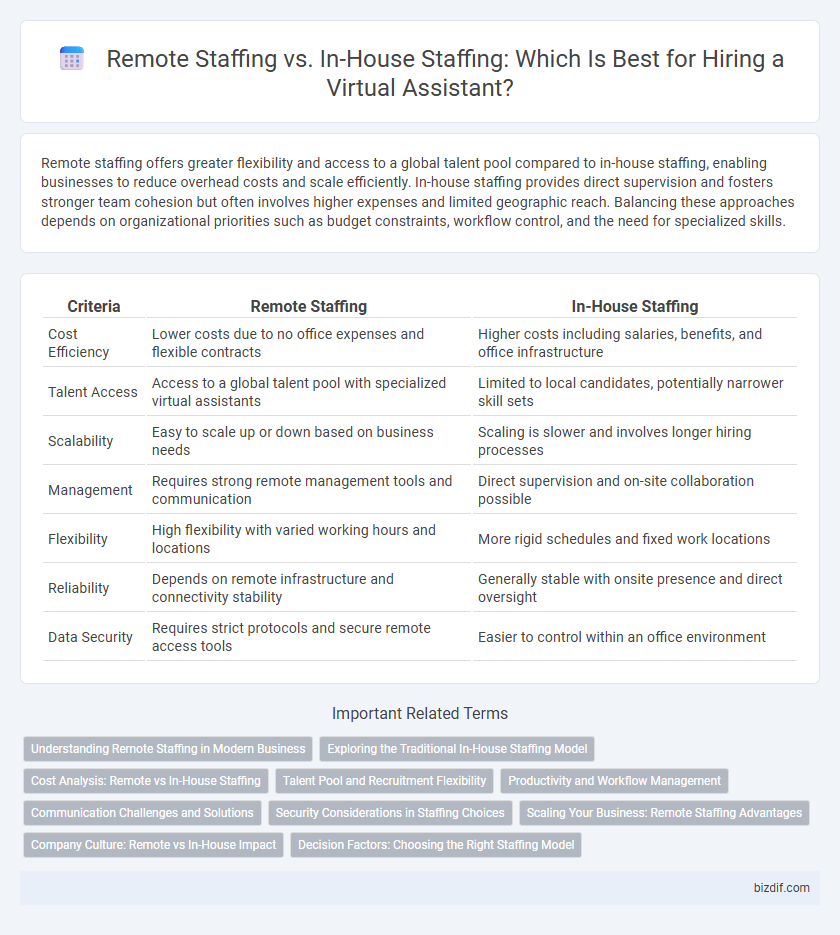Remote staffing offers greater flexibility and access to a global talent pool compared to in-house staffing, enabling businesses to reduce overhead costs and scale efficiently. In-house staffing provides direct supervision and fosters stronger team cohesion but often involves higher expenses and limited geographic reach. Balancing these approaches depends on organizational priorities such as budget constraints, workflow control, and the need for specialized skills.
Table of Comparison
| Criteria | Remote Staffing | In-House Staffing |
|---|---|---|
| Cost Efficiency | Lower costs due to no office expenses and flexible contracts | Higher costs including salaries, benefits, and office infrastructure |
| Talent Access | Access to a global talent pool with specialized virtual assistants | Limited to local candidates, potentially narrower skill sets |
| Scalability | Easy to scale up or down based on business needs | Scaling is slower and involves longer hiring processes |
| Management | Requires strong remote management tools and communication | Direct supervision and on-site collaboration possible |
| Flexibility | High flexibility with varied working hours and locations | More rigid schedules and fixed work locations |
| Reliability | Depends on remote infrastructure and connectivity stability | Generally stable with onsite presence and direct oversight |
| Data Security | Requires strict protocols and secure remote access tools | Easier to control within an office environment |
Understanding Remote Staffing in Modern Business
Remote staffing leverages digital communication and cloud-based tools to connect skilled professionals from diverse locations, enhancing workforce flexibility and reducing overhead costs associated with physical office spaces. Modern businesses benefit from remote teams by accessing a global talent pool and scaling operations quickly without geographic limitations. This approach improves productivity through asynchronous work and promotes a better work-life balance, leading to increased employee satisfaction and retention.
Exploring the Traditional In-House Staffing Model
The traditional in-house staffing model involves hiring employees who work on-site, providing direct oversight and immediate collaboration within the organization. This approach often ensures consistent team integration, but incurs higher costs related to office space, benefits, and equipment. Companies relying on in-house staffing may face longer hiring cycles and limited access to specialized skills compared to remote staffing alternatives.
Cost Analysis: Remote vs In-House Staffing
Remote staffing significantly reduces overhead costs compared to in-house staffing by eliminating expenses such as office space, utilities, and commuting allowances. Companies benefit from flexible payroll models, paying only for the actual hours worked or specific tasks completed, which enhances budget control. In contrast, in-house staffing demands fixed salaries, benefits, and additional operational costs, often leading to higher overall expenditure.
Talent Pool and Recruitment Flexibility
Remote staffing provides access to a global talent pool, allowing companies to recruit specialists with diverse skills and experience beyond geographical limitations. In-house staffing restricts recruitment to local candidates, often limiting talent diversity and availability. Remote staffing offers greater recruitment flexibility by enabling rapid scaling and adaptation to project needs without the constraints of physical office space or local labor markets.
Productivity and Workflow Management
Remote staffing enhances productivity by leveraging flexible schedules and diverse talent pools, enabling seamless workflow management through cloud-based tools and real-time collaboration platforms. In-house staffing offers direct supervision and immediate communication, which can streamline task delegation but may limit scalability and adaptability. Optimizing workflow management relies on integrating tailored project management software that suits the specific staffing model to maximize efficiency and output.
Communication Challenges and Solutions
Remote staffing often faces communication challenges such as time zone differences, lack of face-to-face interaction, and potential technology barriers. Utilizing advanced communication tools like video conferencing, instant messaging, and project management software can enhance collaboration and ensure clarity. Establishing regular check-ins and clear communication protocols minimizes misunderstandings and boosts productivity in remote teams compared to in-house staffing.
Security Considerations in Staffing Choices
Remote staffing requires robust cybersecurity protocols and encrypted communication tools to safeguard sensitive data, as virtual environments are more vulnerable to cyber threats than traditional office setups. In-house staffing allows for greater control over physical and network security, minimizing risks associated with unauthorized access and data breaches. Organizations must weigh these security considerations, including access controls and monitoring capabilities, when choosing between remote and in-house staffing models.
Scaling Your Business: Remote Staffing Advantages
Remote staffing offers unparalleled flexibility for scaling your business quickly, allowing access to a global talent pool without geographic constraints. This model reduces overhead costs associated with in-house staffing, such as office space and equipment, enabling efficient budget allocation toward growth initiatives. Leveraging remote teams enhances operational agility, supporting rapid expansion and adaptability in dynamic market conditions.
Company Culture: Remote vs In-House Impact
Remote staffing fosters a flexible company culture that values autonomy, resulting in diverse collaboration styles and digital communication habits. In-house staffing strengthens face-to-face interaction, promoting immediate feedback and cohesive team dynamics through shared physical workspace. Companies balancing both models can cultivate a hybrid culture that leverages remote flexibility while maintaining in-person connectivity, enhancing employee engagement and productivity.
Decision Factors: Choosing the Right Staffing Model
Remote staffing offers scalability, cost-efficiency, and access to a global talent pool, making it ideal for businesses seeking flexibility and diverse skill sets. In-house staffing provides tighter control, enhanced team cohesion, and direct communication benefits, which suit organizations emphasizing security and immediate collaboration. Key decision factors include budget constraints, project complexity, the need for real-time interaction, and long-term strategic goals.
Remote staffing vs In-house staffing Infographic

 bizdif.com
bizdif.com